
Tobacco and Medicine Menu: 1 2 3 4 5 6 7 8 9 10 11 12 13 14 15 Next>>
Tobacco and Medicine During the Golden Age of Piracy, Page 4
Tobacco's Name
Probably because of its late 'discovery' by Europeans, the tobacco plant
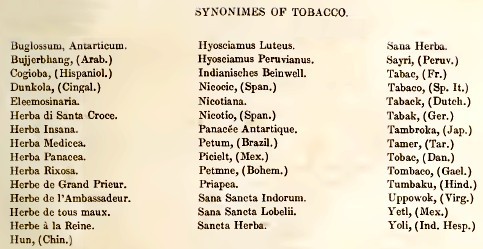
Various Names For Tobacco, From On The History And Properties Chemical And Medical Of
Tobacco,
By William Henry Cleland, 1840, p. 65
was called by a variety of different names. A list of these, some noting the place where it was called by that particular name, was assembled by William Henry Cleland in his 1840 book, which is seen at right. Many of these names are not particularly important to an historic understanding of the tobacco plant. However an explanation of a couple of the names by which tobacco was originally called is useful in understanding some of the references in the older texts.
Several accounts refer to 'petum' or in what are likely misspellings such as petu or petun. This comes from one of the men who is credited with bringing tobacco to France: André Thevet, who mentioned the name in his 1557 book Les Singularitez de Ia France antarctique
[Brazil], autrement nommee Amerique: et de plusieurs terres et isles decouvertes de nostre temps. A 1568 English translation explains , "There is another secrete herbe which they [the native Brazilian Tupi people] name in their language Petun, the which most commonly they beare
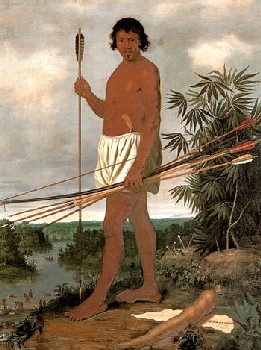
Artist: Albert Eckhout - A Tupi Man (1643)
about them, for that they esteeme it marvellous profitable for many things, this herbe is like to our Buglos."1 Historian Berthold Laufer states that petum comes from "the Tupi-Guarani word pitiima or pitima"2.
Jean Nicot, the other man credited with bringing tobacco to France, provided the "accepted botanical name of Nicotiana"3. This occurred courtesy of the book L'Agriculture et la maison rustique, written by Charles Estienne and Jean Liebault in 1570. As explained in the 1577 English translation, "[I]t is better to name it Nicotiane, by the name of him that sent it into Fraunce first, to the ende that hee may have the honour thereof, according to his desert, for that hee hath enriched our Countrie, with so singular an Hearbe"4. Nicotiana is the Latinized version of Nicot's name.5 Yet another term associated with tobacco sprang from Nicot's name which is readily recognized today: nicotine. However, the psychoactive alkaloid found in tobacco and other plants in the nightshade family today recognized as being both poisonous and addictive, wasn't identified as an element of the plant until 1828. It certainly wasn't known during the golden age of piracy.
Once the plant had found its way to Europe, it acquired a number of other names, some of which appear in the citations in this article. Among these were 'Herba di Santa Croce' in honor of Cardinal Prosper de Santa Croce who introduced tobacco to Italy in 15896, 'Herba Medicea' which is Latin for medical herb, 'Herba Panacea' in reference to tobacco's suggested ability to heal a wide variety of illnesses and is found in the title of Giles Everard's 1587 book7, 'Herbe de l'Ambassadeur' or the Ambassador's Herb which refers to Jean Nicot's time as the French ambassador to Portugal in 1559-61, 'Sana Sancta Indorum' or sacred Indian health (plant) which was used by John Gerard in his herbal in 15978 based on the title given by Matthias de l'Obel & Pierre Pena in their 1570-1 herbal9, 'Sana Sancta Lobelii' or sacred health (plant) of l'Obel, 'Sancta Herba' or sacred herb and 'Sana Herba' or health herb, both of which are found in Gerard's Herball.
Curiously, the word tobacco, which comes from the language of the Taino natives of Hispaniola (modern Haiti) never referred to the plant before the Spanish used it that way.
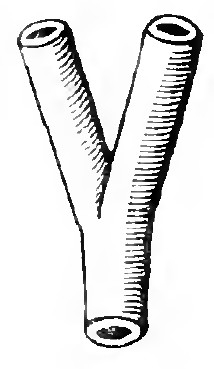
A Tabago Pipe, Based on the Original
in Oviedo's 1547 Historia General de las
lndias (1847)
Oviedo noted that the word referred to a type of pipe the Taino used to smoke the leaves in his 1514 book Historia General de las lndias. Oviedo describes the pipe as being "about a span [nine inches] long; and when used the forked ends are inserted in the nostrils, the other end being applied to the burning leaves of the herb. ...this implement is called tabaco by the Indians"10. He specifically says that the pipe, not the herb was called tabaco.11
Some early authors suggest that the name Tobacco is a corruption of the name of the Caribbean Island Tobago. Sea surgeon John Atkins says, "To the Dutch belong in whole or part… Tobago, or Tobacco Island; so called, from the Plenty of that Weed there, or the Weed so called, as first transplanted thence."12 While interesting, this explanation does not appear to be entirely correct. The current name first appeared on Spanish maps dating to 1511.13 The natives of the islands around Tobago called the island by completely different names including 'Urupaina' (meaning 'big snail' according to Vázquez de Espinosa in his Compendium and description of the West Indies) and Aloubaéra according to French missionary Raymond Breton who worked among the Kalinago natives.14 So Tabago is almost certainly of Spanish origin. Professor Arie Boomert of Leiden University suggests, "We may conclude that the name Tobago represents a descriptive toponym, coined by some unknown Spanish sailor, possibly a slaver from Hispaniola, who passed by the island in the first decade of the sixteenth century and called it Tabaco as its contour reminded him of the cigars the Taíno were accustomed to smoke."15
1 André Thevet, The new found vvorlde, or Antarctike wherin is contained wo[n]derful and strange things, 1568, p. 49r; 2 Berthold Laufer, "The Introduction of Tobacco into Europe", Field Museum of Natural History, Department of Anthropology, Chicago, Leaflet Number 19, 1924, p. 49;3 Count Eugenio Courti, A History of Smoking, Translated by Paul England, 1932, p. 60; 4 Charles Estienne and Jean Liebault, Joyfull Newes out of the newfound world, John Frampton, translator, 1577, f42v; 5 Of the Use of Tobacco, Coffee, Chocolate, Tea and Drams, 1722, p. 2; 6 William Penn, The Soverane Herb, 1902, p. 13-4; 7 Giles Evarard, PANACEA, Or The Universall Medicine; Being a Discourse and Discription of TOBACCO, With its Preparation and Use, 1659; 8 John Gerard, The Herball or General Historie fof Plantes, 2nd ed, 1636, p. 358; 9 "Indorum Sana SANCTA, sive Nicotiana Gallorum", Matthias de l'Obel & Pierre Pena, Stirpium adversaria nova, 1570-1, p. 251; 10 Gonzalo Fernández de Oviedo, Historia General de las lndias, Libra V., Capit. 2., Edit. 1535, Translated by William Andrew Chatto (as Joseph Fume), A Paper: - Of Tobacco, 1839, p. 14; 11 William Andrew Chatto (as Joseph Fume), A Paper: - Of Tobacco, 1839, p. 15; 12 John Atkins, A Voyage to Guinea and Brazil, 1735, p. 221; 13,14 Arie Boomert, "Names for Tobago", Journal de la Societe des Americanistes, journals.openedition.org, gathered 8/2/18, not paginated
Tobacco Plant
“Tobacco is originally a sub-tropical plant, which flourishes best in the ideal climate of the Antilles and the more westerly regions of Central and sub-tropical America.” (Count Eugenio Courti, A History of Smoking, Translated by Paul England, 1932, p. 26)
While tobacco made its way to the European and Asian continents in the 16th century, the best tobacco was thought to come from upper South American, Central American, Caribbean and lower North American areas. As previously noted,
Photo: H. Zell - Nicotiana Tabacum
tobacco was grown in a variety of these locations including Brazil, Virginia, Mexico, Cuba and the Dominican Republic. In addition, the English, upon recognizing "that tobacco was a crop from which quick profits could be taken... colonies were founded on St. Kitts (1624), Barbados (1625), Nevis (1628), Antigua (1632), and Montserrat (1650). Similar attempts were made on Tobago and St. Lucia but failed"1.
Two types of tobacco were used in smoking, chewing and snuff: Nicotiana tabacum (N.tabacum) and Nicotiana rusticum (N.rusticum). Because this now well-understood taxonomy was not yet developed2, figuring out which type was found where during the golden age of piracy can be a bit confusing. Plant biologist Richard Firn explains, "at the start of the seventeenth century, Europeans first encountered the Amerindians in the English colony of Virginia and the found a culture of smoking Nicotiana rusticum."3 Botanist Ken Thompson says, that although Sir Walter Raleigh smoked N.rusticum, "it contains dangerously high levels of nicotine, so was quickly superseded by the milder N. tabacum."4 Toxicologist Brent Furbee explains that "Nicotiana rustica, which contains up to 18% nicotine, is thought to have been the first tobacco export from the New World. Much more potent than Nicotiana tabacum (0.5% to 9% nicotine), it is still smoked in Turkey and serves as a source for commercial nicotine production."5 'Commercial production' refers to its' use for things other than personal consumption such as insecticides.
How the switch from N.rusticum to N.tabacum for commercial use was made is not entirely clear. According to one author, John Rolfe introduced N.tabacum to the English Virginian colony of Jamestown, having "mysteriously acquired the seeds of Nicotiana tobacum from a Spanish plantation, which gave rise to plants with a milder flavor"6. However, N.tabacum proved to be the better choice. Plant biologist Firn points out several other qualities of the milder N.tabacum which made it a good choice for growing: "it is a remarkably adaptable species... processing of the plant is relatively simple... and it is easy to store, distribute and transport."7
With this modern overview of the types of tobacco produced in the New World in mind, this section will look first at how tobacco was described before and during the golden age of piracy, then at the way in which it was commercially grown and finally at how it was harvested and processed for use and shipment.
1 Kenneth Gordon Davies. The North Atlantic World in the Seventeenth Century, 1974, p. 39; 2 The modern botanical taxonomy was established by Carl Linnaeus in Species Plantarum in 1753. He included four varieties of tobacco: Nicotiana glutinosa, Nicotiana tabacum, Nicotiana rustinca and Nicotiana paniculata. This has since been expanded over time to include 76 naturally occurring species. (Sandra Knapp, Mark W. Chase & James J. Clarkson, "Nomenclatural changes and a new sectional classification in Nicotiana (Solanaceae)", TAXON, 53(1), February 2004, p. 73) Modern historians suggest that authors describing tobacco plants during the fifteenth through seventeenth centuries primarily described two species: Nicotiana rusticum and Nicotiana tabacum. Both of these were 'cultivated' tobaccos, being specifically grown for use in smoking, snuff and chew. 3 Richard Firn, Nature's Chemicals: The Natural Products That Shaped Our World, 2010, p. 41; 4 Dr. Ken Thompson, "The toxic charms of nicotiana", The Telegraph, gathered online 8/7/18; 5 Brent Furbee, “Neurotoxic Plants”, Clinical Neurotoxicology, 2009, p. 535; 6 Andrew Edmund Slaby, "Acayatl's Curse", The Clinitcal Management of Nicotine Dependence, James A. Cocores, ed., 2012, p. 7; 7 Firn, p. 41
Tobacco Plant Description
Many of the later descriptions of tobacco up to and including those found in the golden age of piracy books come from three early sources - Frenchmen Charles Estienne and Jean Liebault (1570), Spaniard Nicolás Monardes (1571) and Englishman John Gerard (1597).
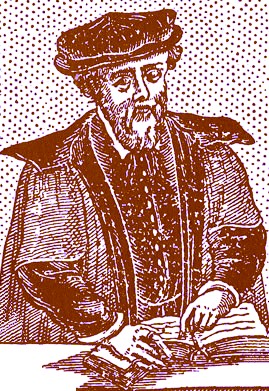
Nicolás Monardes (1569)
The English translation of the first two sources was published by John Frampton in 1577 (the republished 1580 version is used here). Being written so long before the modern plant taxonomy was established, it was impossible for these sources to give the scientific name for the plants they were describing. However, botanist Ken Thomas briefly describes the two cultivated tobacco species in a way which makes translating these older texts possible: "N. rustica is not very attractive and N. tabacum is enormous."1 The size of the plant is particularly telling. Most of the ancient authors only describe one type of tobacco.
John Gerard describes two types of cultivated tobacco. "There be two sorts or kinds of Tabaco, one greater, the other lesser".2 As promising as this sounds, he goes on to discuss the second plant as being native to Peru. He explains that this species "hath very great stalkes of the bignesse of a childes arme, growing in fertile and well dunged ground of seven or eight foot high, dividing it selfe into sundry branches of great length"3. This is almost certainly N.Tabacum. However, Gerard mentions a third type of tobacco plant which he calls 'Dwarfe Tabaco' which actually does appear to be N.rustica.
All of the old texts describe Nicotiana Tabacum. Monardes' descriptions say that tobacco "does growe and come to bee verie greate: many times to bee greater then a Lemmon tree."3 This may be why anthropologist and historical geographer Berthold Laufer positively identifies Monardes description as being N.Tabacum.4 Estienne and Liebault provide a more extensive description, noting that the plant "hath the stalke greate, bearded and slymie, the leafe large and long bearded slymie, it growth in branches halfe foote to halfe foote, and is very ful of leaves, and growth in height foure or five foote."5
Because there are more 16th century sources for N.Tabacum, it is more fully described. Of the
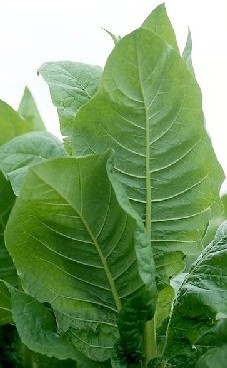
Photo: T. Voekler - Nicotiana Tabacum Leaves
stalk of the plant, Monardes says "It casteth foorth one steame [stem] from the roote which groweth upright, without declining to any parte, it sendth foorth many Bowes, straight that wel neere they be equal with the principal steame [stem] of the tree"7. Estienne and Liebault say that, "It sproutes foorth neere the roote much"8.
With regard to the N.Tabacum leaf, Estienne and Liebault explain that the plant is "nyne or tenne months in the yeere laden, in one selfe tyme, with leaves" in hot countries.9 Monardes suggests the leaves are like those of a lemon tree and "come to be very greate, and be of color greene, the Plant is heavie, ...all the yeere they are greene, and have leaves, and if any wyther, they be those that are lowest"10. Gerard adds that there "are placed in most comly order very faire long leaves, broad, smooth, and sharp pointed, soft, and of a light green colour, so fastned about the stalke, that they seeme to embrace and compasse it about."11
Estienne and Lirbaut, go into great detail about the 'codde' by which they appear to mean the part of the flower containing the seeds. Of this they say, "when they [are] waxed blacke, ...to be ripe, which is when they are yet greene... and reupueth by a greate quantitie of buddes, notwithstanding the grain is the least seede in the worlde"12. Monardes provides a more
Photo: H. Zell - Nicotiana Tabacum Flowers
satisfying explanation of the flower and seeds, which helps to clarify Estienne and Liebault's description. He says that "in the highest parte of all the Plante, there doeth growe out the flower, the which is... in the middest of Carnation color [purple-pinkish], it has a good shewe when it is drie, it is like to blacke Poppie seede, and is it is shut up the seed which is very small, and of the color of a darke Tauny."13 Gerard provides more information on the flowers themselves. "The floures grow at the top of the stalks, in shape like a bell-floure, somewhat long and cornered, hollow within, of a light carnation colour, tending to whitenesse toward the brims. The seed is contained in long sharpe pointed cods or seed-vessels like unto the seed of yellow Henbane, but somewhat smaller, and browner of colour."14
Estienne and Liebault state that "the rootes be like small threeds."15 Monardes has a great deal more to say about the root: "The roote is great, conformable to the greatnesse of the Plante, devided into many partes, and it is like to Wood in substaunce, the which beeyng parted, it has the hearte within, like unto the color of Safron, and beeyng tosted, it has some bitternes with it. The Rinde comes away easily, we know not that the roote hath any virtue at all."16 His fascination with the root likely comes from the fact that the roots of
Photo: Magnus Manske - Nicotiana Rustica Plant
several other plants, such as gentian, licorice and marshmallow, were considered to be their most medicinally valuable part. Gerard is unusually terse on the subject, adding little to what Estienne and Liebalt and Monardes mention, possibly because the root appears to have no medical use.
Nicotiana rusticum is called by a variety of names, most indicating its size and less appealing appearance, including 'small tobacco', 'native tobacco', 'Aztec tobacco' and 'wild tobacco'.17 Several 17th century herbal books refer to it as Nicotiana minor. Gerard refers to Nicotiana rusticum as dwarf tobacco as noted. He explains that this plant is "som span [about nine inches] or better long... The floures are much less [smaller] than those of the yellow Henbane, and of a greenish yellow. The leaves are small, and narrower than those of Sage of Jerusalem. The root is small and fibrous."18 Gerard says that this species that doesn't have as much of a "hot and burning" taste as N.tabacum, which is interesting given that the plant contains more nicotine. This plant appears to have fallen out of favor in the early 17th century, however.
1 Dr. Ken Thompson, "The toxic charms of nicotiana", The Telegraph, gathered online 8/7/18; 2,3 John Gerard, The Herball or General Historie of Plantes, 2nd ed., 1636, p. 357; 4 Nicholás Monardes, "Of the Tabaco and of His Greate Vertues", Joyfull Newes out of the new found world, 1580, John Frampton, translator, f.34r; 5 Berthold Laufer, "The Introduction of Tobacco into Europe", Field Museum of Natural History, Department of Anthropology, Chicago, Leaflet Number 19, 1924, p. 55; 6 Charles Estienne and Jean Liebault, “La Maison rustique”, Joyfull Newes out of the new found world, 1580, John Frampton, translator, f.43v; 7 Monardes, p. f.34r-v; 8,9 Estienne and Liebault, f.43v; 10 Monardes, p. f.34v; 11 Gerard, p. 357; 12 Estienne and Liebault, f.43v; 13 Monardes, p. f.34v; 14 Gerard, p. 357; 15 Estienne and Liebault, f.43v; 16 Monardes, p. f.34v; 17 "Nicotiana rustica Linnaeus", Global Biodiversity Information Facility website, gbif.org, gathered 8/11/18; 18 Gerard, p. 358

